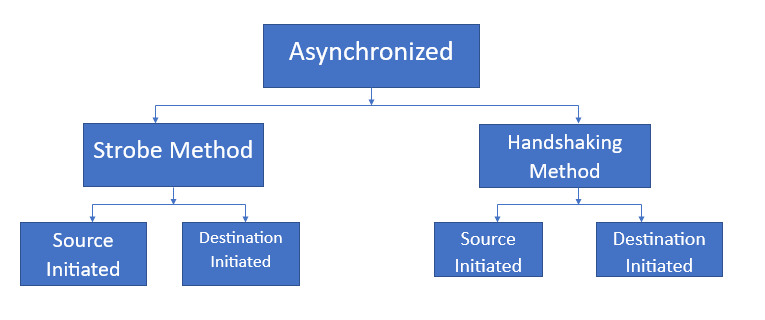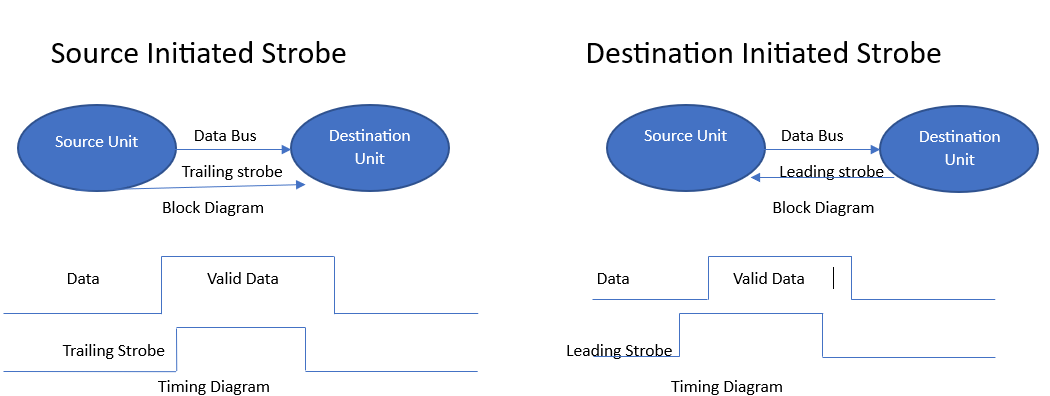Asynchronous Data Transfer
Last Updated :
23 Jul, 2025
Asynchronous data transfer enable computers to send and receive data without having to wait for a real-time response. With this technique data is conveyed in discrete units known as packets that may be handled separately. This article will explain what asynchronous data transfer is, its primary terminologies, advantages and disadvantages, and some frequently asked questions.
Terminologies used in Asynchronous Data Transfer
- Sender: The machine or gadget that transfers the data.
- Receiver: A device or computer that receives data.
- Packet: A discrete unit of transmitted and received data.
- Buffer: A short-term location for storing incoming or departing data.
Classification of Asynchronous Data Transfer
- Strobe Control Method
- Handshaking Method
 Classification of Asynchronous Data Transfer
Classification of Asynchronous Data TransferStrobe Control Method For Data Transfer
Strobe control is a method used in asynchronous data transfer that synchronizes data flow between two devices. Bits are transmitted one at a time, independently of one another, and without the aid of a clock signal in asynchronous communication. To properly receive the data, the receiving equipment needs to be able to synchronize with the transmitting device.
Strobe control involves sending data along with a different signal known as the strobe signal. The strobe signal alerts the receiving device that the data is valid and ready to be read. The receiving device waits for the strobe signal before reading the data to ensure sure it is synchronized with its clock.
The strobe signal is usually generated by the transmitting device and is sent either before or after the data. If the strobe signal is sent before the data, it is called a leading strobe. If it is sent after the data, it is called a trailing strobe.
 Types of Strobes
Types of StrobesIt is advantageous to utilize strobe control because it enables asynchronous data transfer, which is helpful when the participating devices have dissimilar clock rates or are not synchronized. The time of data transfer is also made more flexible by strobe control since the receiving device doesn't have to synchronize with the transmitting device's clock; instead, it can wait for the strobe signal before reading the data.
Overall, strobe control, which is frequently employed in a range of electronic devices and systems, is a helpful technique for assuring dependable data flow in asynchronous communication.
Handshaking Method For Data Transfer
The strobe method has a limitation in that the initiating source unit cannot confirm whether the destination unit has received the data placed on the bus. Similarly, the destination unit cannot verify if the source has placed data on the bus. This issue is resolved by the handshaking method which introduces a second control signal line to confirm the transfer between units.
In this method, one control line follows the data flow from the source to the destination and allow the source to inform the destination whether valid data is on the bus. The other control line runs in the opposite direction from the destination to the source and enable the destination to notify the source about its ability to accept data. The control sequence depends on which unit initiates the transfer as the process varies based on whether the source or destination is initiating the exchange.
During an asynchronous data transfer, two devices manage their communication using handshaking. It is guaranteed that the transmitting and receiving devices are prepared to send and receive data. Handshakes are essential in asynchronous communication since there is no clock signal to synchronize the data transfer.
Source-Initiated Handshaking:
The timing diagram shows the signal exchange between two units during data transfer. The source unit initiates the transfer by placing data on the bus and enabling the "data valid" signal. The destination then activates the "data accepted" signal after accepting the data. The source disables the "data valid" signal, invalidating the data, followed by the destination disabling the "data accepted" signal, returning the system to its initial state. The source waits for the destination to signal readiness by disabling "data accepted" before sending the next data item. This sequence is shown in the sequence diagram.
 Source initiated handshaking
Source initiated handshakingDestination Initiated Handshaking:
In the block diagram, the two handshaking signals are "data valid" from the source unit and "ready for data" from the destination unit, with "data accepted" renamed to "ready for data" to reflect its updated meaning. In destination-initiated transfer, the source waits for the "ready for data" signal from the destination before placing data on the bus. The handshaking process then follows the same sequence as in the source-initiated transfer.
 Destination initiated handshaking
Destination initiated handshakingAdvantages of Asynchronous Data Transfer
- Because asynchronous data transfer sends data in discrete, independently processable pieces, it enables faster data transfer speeds
- This method is more effective than synchronous data transfer because there is no need for the receiver to respond.
- Transmission is done by making large files or data sets into smaller packets and sending them in parallel cuts the duration time.
Disadvantages of Asynchronous Data Transfer
- Asynchronous data transfer requires more complex programming and it may be possible that some data may get corrupted or lose data if packets are not received in the correct order or are lost during transmission.
- As we know there will be no real-time communication in asynchronous data transport can be more prone to errors than synchronous data transfer.